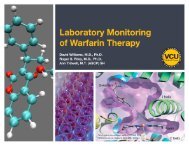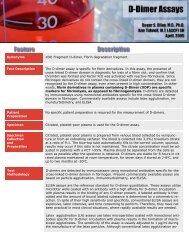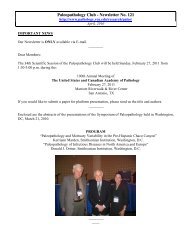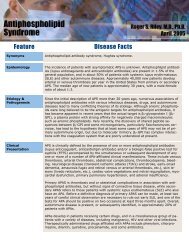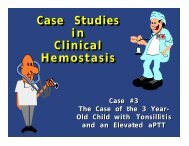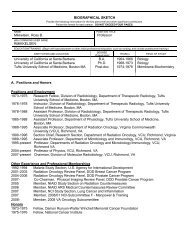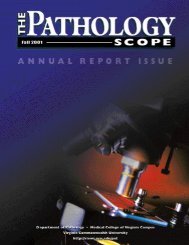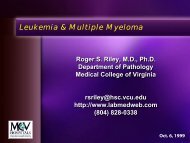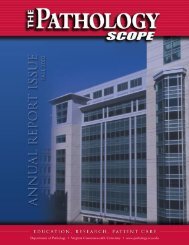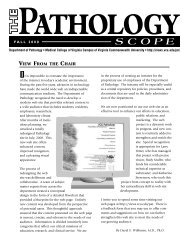What You Should Know About Abnormal Blood Clotting - Pathology
What You Should Know About Abnormal Blood Clotting - Pathology
What You Should Know About Abnormal Blood Clotting - Pathology
You also want an ePaper? Increase the reach of your titles
YUMPU automatically turns print PDFs into web optimized ePapers that Google loves.
Deadly <strong>Pathology</strong>/Killer <strong>Blood</strong> Clots<br />
Roger S. Riley, M.D., Ph.D.<br />
2<br />
Most individuals who develop thromboembolism have one or more risk factors. Many of the non-inherited<br />
(acquired) risk factors have been recognized for decades, but a rapid series of scientific discoveries over the past<br />
two decades have lead to the recognition of numerous inherited (genetic) factors that can either increase or<br />
decrease an individuals risk of developing thromboembolic disease. These inherited factors act in conjunction with<br />
the acquired risk factors and involve the vessels, blood platelets, and the chemicals in the blood that are part of<br />
the clotting process. The term thrombophilia refers to individuals who have a tendency to develop thrombosis<br />
from either acquired or inherited causes, or both. In view of the enormous amount of medical resources needed to<br />
care for patients with thromboembolic disease, there is a great interest in the identification and early treatment of<br />
patients who have a high risk of developing thromboembolic disease. Many new laboratory tests and drugs are<br />
available for this purpose. This paper will focus on venous thromboembolism, although much of the information<br />
also pertains to<br />
arterial thrombosis.<br />
1200000<br />
1000000<br />
800000<br />
600000<br />
400000<br />
200000<br />
0<br />
Thrombosis Lung disease Trauma Cancer Other<br />
Causes of Mortality<br />
Fig 1. Leading causes of mortality in the United States. From Fareed et al. Semin. Thromb. Hemost. 26:5-21,<br />
2000.<br />
An Introduction to Hemostasis and Thrombosis<br />
Hemostasis is series of physiologic processes that confine blood to the vascular spaces, maintain the fluidity of<br />
blood, and stop bleeding when injury to a vessel occurs. Hemostasis is a complex process based upon interactions<br />
among the blood vessels and supporting tissues, endothelial cells, platelets, plasma coagulation proteins,<br />
physiologic protease inhibitors, and the fibrinolytic system. Alterations in the hemostatic system can result in<br />
significant pathologic bleeding or clotting.<br />
Resistance to bleeding is provided by: (1) extravascular forces, (i.e., pressure exerted by the skin and supporting<br />
tissue), (2) the physical resistance provided by the blood vessel itself, and (3) substances present within the blood<br />
(e.g. the platelets and coagulation factors). Vessels constrict when injured, limiting the flow of blood to the injured<br />
area. Platelets adhere to collagen fibers exposed by the vascular damage and clump (aggregate) to form a loose,<br />
temporary (primary) plug. The plasma protein fibrinogen helps to stimulate platelet aggregation. Aggregated<br />
platelets undergo a series of mechanical (shape change) and biochemical changes termed activation. Activated<br />
platelets release chemical substances that activate other platelets and initiate the coagulation cascade.<br />
Coagulation generates a fibrin mesh, which stabilizes the platelet plug. The process of healing and recovery is also<br />
initiated to restore normal function to the vessel. The endothelium heals and the blood clot is dissolved through



